This is a nice view from the side of the terminal; there's the Manila Central Post Office, FEATI and SM Carriedo with its characteristic disk roof (not rotatory, I'm afraid). There's a man paddling his small boat behind one of the catamarans. On this day, several milkfishes have been released by the recent typhoon from their pens at the Laguna de Bai hence the riverbanks are full of people hoping to get the chance to catch something for lunch.
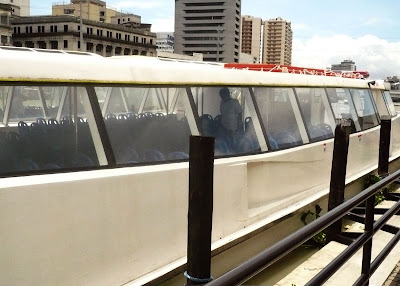
A ferry, bathed in light, sits beside the terminal awaiting its passengers. The river is very calm today.
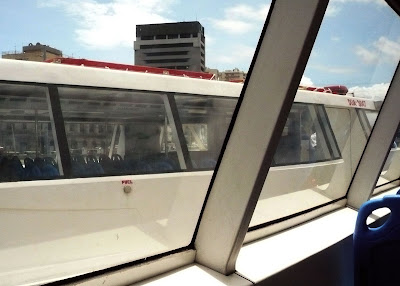
Now there's two of them side by side. There's only one gangplank. You get to the other ferry through the first one which is right beside the terminal. Amusing, isn't it?
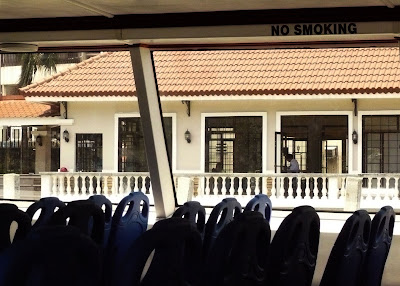
Leaving the terminal now, yipeee! An adventure trip come true! The Plaza Mexico terminal retains the flavor of Spanish-period Filipino architecture. This is in compliance with the rules that govern the Walled City and its environs as enforced by the Intramuros Administration.
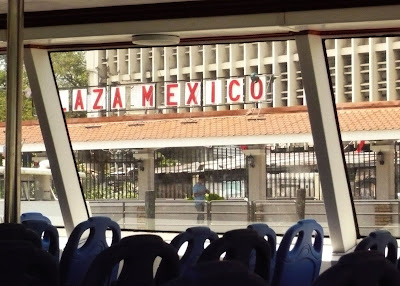
The first (or last) station is Plaza Mexico named after the commemorative plaza nearby. The Plaza celebrates 100 years of Philippine-Mexican Friendship.
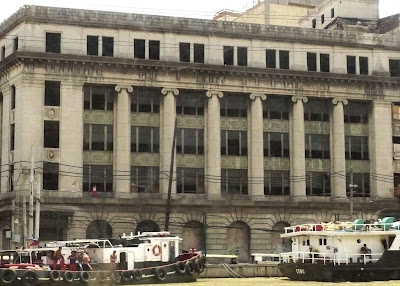
This hollow shell of a building is the Pacific Commercial. It used to house Citibank. Despite having fallen into disuse, however, it still retains most of its beauty and still exudes strength and power.
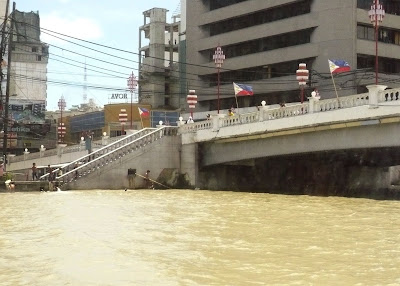
Jones Bridge. This end lies on the side of Binondo, Manila's Chinese old business district. From here you can see the famous fried chicken house, SAVORY.
I am reminded of the brass sculpture of little boys jumping into the river in Singapore which you can also see when you take the river tour from Boat Quay.


Our first stop was Escolta Station. The station is a delight to watch from the Jones Bridge. It is very clean and compact, standing as it is on the renovated portion of the Muelle del Banco in Escolta, Manila's first financial and business district.
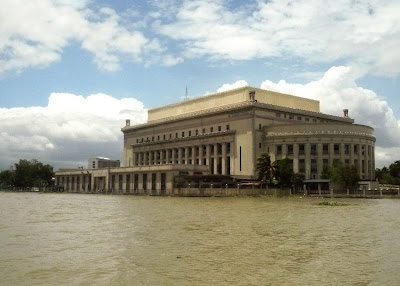
The majestic, neo-classical 82-years old (c. 1926) Manila Central Post Office basking in the sun. It was designed by Juan Marcos de Guzman Arellano. The Jones Bridge above was also designed by Arellano, but do note that the Jones Bridge we know now isn't the original as most of these Arellano structures were destroyed during WWII. Anyway, please find below a photo of how the original structure looked like courtesy of The National Archives.

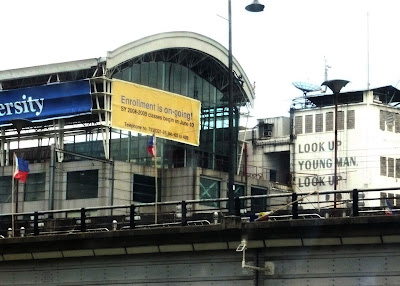
On your left is the FEATI University, the only university in the country (or probably in the world) with a light rail transit bisecting its campus. For most of us who spent our childhood in Manila (and in these parts of the metro), we remember with fondness the words, LOOK UP, YOUNG MAN, LOOK UP.


Our first stop was Escolta Station. The station is a delight to watch from the Jones Bridge. It is very clean and compact, standing as it is on the renovated portion of the Muelle del Banco in Escolta, Manila's first financial and business district.

The majestic, neo-classical 82-years old (c. 1926) Manila Central Post Office basking in the sun. It was designed by Juan Marcos de Guzman Arellano. The Jones Bridge above was also designed by Arellano, but do note that the Jones Bridge we know now isn't the original as most of these Arellano structures were destroyed during WWII. Anyway, please find below a photo of how the original structure looked like courtesy of The National Archives.

Moving on...

On your left is the FEATI University, the only university in the country (or probably in the world) with a light rail transit bisecting its campus. For most of us who spent our childhood in Manila (and in these parts of the metro), we remember with fondness the words, LOOK UP, YOUNG MAN, LOOK UP.
QUIAPO STATION. I was very disappointed when we reached the Quiapo Station. I mean, there's no station to speak of as if putting this stop here was just an afterthought. The squalor surrounding this area is just too difficult to comprehend. Here you can also see the Quiapo (Quezon) Bridge with its moderne concrete posts. Beneath is Quinta Market, famous for its numerous shops selling Philippine traditional handicrafts.
No, this isn't the market I was referring to earlier. :-(
AYALA BRIDGE. This bridge, Ayala Bridge, heralds the entrance of the ferry into the territory of the Hospicio de San Jose. Located at the Isla de Convalescencia, Hospicio de San Jose is a Catholic Welfare institution and a home of orphans, abandoned and special children and elderly people. Let me post here its history (courtesy of the Archdiocese of Manila website):
The establishment of Hospicio de San Jose was made possible y the charitable legacy of Don Francisco Gomez Enriquez and his wife Dona Barbara Versoza. In gratitude for having been cured of a fever, Don Francisco donated four thousand pesos (P4,000) in 1778 for the establishment of a Hospicio General for the poor of Manila. It was said that several others followed the first sum during the couple's lifetime.
Unfortunately, they did not live long enough to see the actual foundation of this home they envisioned to take care of the city's poor and unwanted children.The initial purpose of the establishment of the institution was mainly to respond to the urgent need of the indigent clientele and the mentally/physically handicapped people during those times.
Since its foundation in October 1778, Hospicio de San Jose has continued to meet the needs of the indigent people including the physically handicapped and the elderly people.The institution was first known as Hospicio General and was later changed to its present name Hospicio de San Jose. The newly established welfare institution was then named after St. Joseph, its present saint.
Hospicio de San Jose was formerly located at Pandacan, and then transferred to Intramuros, then to Binondo, Nagtahan and Echague. It was only 1810 when Hospicio de San found its permanent home at the Isla de Convalescencia or the Island of Convalescents.On December 27, 1810, a Board of Directors governed Hospicio ded san Jose through a Royal Decree, under the chairmanship of the Archbishop of Manila. The Daughters of Charity of St. Vincent de Paul came to Hospicio de San Jose only on June 1, 1866 as the administrators and were entirely responsible for the whole operation of the institution.
One of Manila's prominent ladies, Dona Margarita Rojas who was also one of its benefactors suggested to the Governor General to invite the good sisters of Charity to come to the Philippines to take care of the island's poor, sick, handicapped and abandoned.
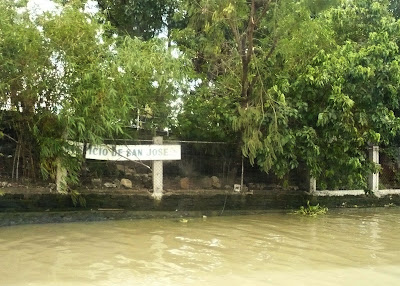
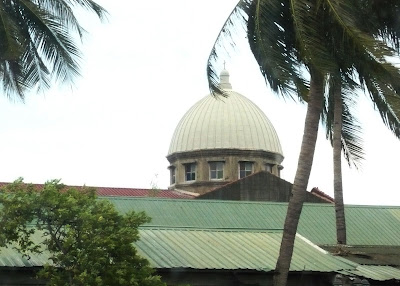
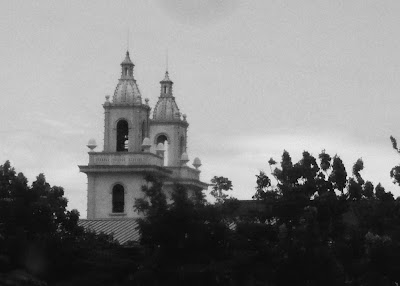
The establishment of Hospicio de San Jose was made possible y the charitable legacy of Don Francisco Gomez Enriquez and his wife Dona Barbara Versoza. In gratitude for having been cured of a fever, Don Francisco donated four thousand pesos (P4,000) in 1778 for the establishment of a Hospicio General for the poor of Manila. It was said that several others followed the first sum during the couple's lifetime.
Unfortunately, they did not live long enough to see the actual foundation of this home they envisioned to take care of the city's poor and unwanted children.The initial purpose of the establishment of the institution was mainly to respond to the urgent need of the indigent clientele and the mentally/physically handicapped people during those times.
Since its foundation in October 1778, Hospicio de San Jose has continued to meet the needs of the indigent people including the physically handicapped and the elderly people.The institution was first known as Hospicio General and was later changed to its present name Hospicio de San Jose. The newly established welfare institution was then named after St. Joseph, its present saint.
Hospicio de San Jose was formerly located at Pandacan, and then transferred to Intramuros, then to Binondo, Nagtahan and Echague. It was only 1810 when Hospicio de San found its permanent home at the Isla de Convalescencia or the Island of Convalescents.On December 27, 1810, a Board of Directors governed Hospicio ded san Jose through a Royal Decree, under the chairmanship of the Archbishop of Manila. The Daughters of Charity of St. Vincent de Paul came to Hospicio de San Jose only on June 1, 1866 as the administrators and were entirely responsible for the whole operation of the institution.
One of Manila's prominent ladies, Dona Margarita Rojas who was also one of its benefactors suggested to the Governor General to invite the good sisters of Charity to come to the Philippines to take care of the island's poor, sick, handicapped and abandoned.















1 comment:
those two spires belong to the shrine of st. michael and the archangels in malacañan. it is the parish of the president of the republique.
i admire you for your in-depth research. ang galing-galing ni junie! mabuhay!
Post a Comment